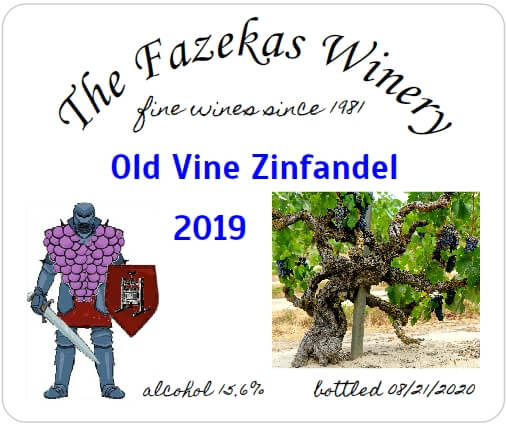2019 Zinfandel
October 2019
This is Old Vines Zinfandel from Lodi, CA. It should be interesting.
I could not identify the vineyard, but the shipping label reads “Linderella, The Perfect Fit”. The logo is a woman’s high heel shoe.

April 2021
I decided to relabel some of my older wines with my current style label, which uses a graphic as the background. I took the graphic from the original label, faded and stretched it.

Ingredients
| Grape | 180# Old Vine Zinfandel from Lodi, CA |
| Pectic Enzyme | 60 drops liquid |
| Yeast | 2 packages Red Star Premier Rouge 1 package Red Star Premier Rouge |
| Yeast Nutrient | 2 tsp, initially |
| Fermentation Oak | 8 oz American oak chips, heavy toast |
| Fermax | 10 tsp |
| Sulfite | potassium metabisulfite added at various points (see below) |
| Fining Agent | 4 tsp bentonite |
| Acid | acid blend added at various points (see below) |
| Aging Oak | 4 oz medium toast French oak cubes |
Method
| Crushed & destemmed the grapes, let rest. | 10/19/2019 SG 1.110 |
| Added pectic enzyme, yeast rehydrated with 2 tsp nutrient, and fermentation oak. | 10/20/2019 SG 1.110 |
| Added Fermax, punched cap down. Was not visibly fermenting the way the Merlot was, so added another package of rehydrated yeast.
Cap is punched down daily, will not check SG again until Friday. Added 1 tsp acid blend per day for 3 days to increase acid without shocking the yeast. |
10/21/2019 SG 1.110 |
| Drained free run juice and pressed lightly. Moved to carboys. Pomace used for second run wine. | 10/27/2019 SG 1.008 |
| Racked. Stirred wine to reduce CO2 and added 4 tsp bentonite and 1/2 tsp K-meta, as I have about 11 gallons. | 11/11/2019 SG 0.994 |
| Racked, added 1/2 tsp K-meta and 10 total tsp acid blend as pH is still around 4.0. Total volume is a bit over 11 gallons.
Blending has begun! The last gallon jug was not full, so I added 1 bottle of Malbec and half a bottle of Merlot to fill it. |
11/26/2019 SG 0.994 |
| Did a pre-tasting, doing some blending. 10% of this blended with 10% Malbec and 80% Merlot produced the best Merlot. This one is second behind the Merlot. | 01/18/2020 SG 0.994 |
| Racked. Added 1/2 tsp K-meta to entire 10 gallons.
Added 4 oz medium toast French oak cubes to demijon, none to the 3.5 gallon carboy. |
03/01/2020 SG 0.995 |
| Racked, removing oak cubes. Homogenized the two containers by racking half of each in separate primary fermenters. Moved the wine into 5 gallon carboys, as the demijohn is harder to work with. Added 1/4 tsp K-meta to each carboy. | 06/28/2020 SG 0.995 |
| Racked half into separate fermenters, homogenizing the 2 carboys. Added 1/4 tsp K-meta to each carboy and bottled. | 08/21/2020 SG 0.995 |
Notes
| Yield | 51 bottles |
| Alcohol | 15.6% |
| 08/21/2020 | The taste at bottling is great! It’s still green-ish and needs another 6 to 12 months aging in the bottle. That said … I’ll probably crack a bottle at Christmas. |
| 05/19/2021 | I am very pleased with this one. When I poured a glass, the color had deepened and the nose is fruity. The first taste is very fruit forward — but not the “fruitiness to the point it tastes sweet”. That faded into an oakiness that is still a bit rough. Totally drinkable now, but another 1 to 1.5 years will make a huge difference. |
| 06/13/2022 | A year later? The aroma is definitely Zin! If I think about it, the oak is a bit stronger than I prefer, but overall the oak blends well into the fruit and the ABV. I was concerned early on as the wine tasted hot — it no longer tastes hot, but anyone drinking it need to keep in mind that it’s 25% stronger than a typical 12% ABV table wine. |
| 02/23/2024 | Opened the final bottle tonight. As has been my habit, I poured 2 glasses, unaerated and aerated with a duck aerator.
Unaerated: This has strong Zin fruit in the taste, but there is an undercurrent of tannin that is a bit harsh. Unfortunately the aftertaste fades into a bit of harsh oak, and I can taste the alcohol. Aerated: Taste is more balanced than the unaerated — The fruitiness is lighter and the tannin lost its harshness as the aeration softened it. Oak is prominent in the aftertaste, but it’s not harsh. Unfortunately, the high ABV stands out as unbalancing. It’s far better than it was, but still unbalancing. When I made this one, I had not used fresh grapes in 20 years. In hindsight, I pressed way too early. If I had waited another 2 days, the wine would have been heavier and would have been more balanced. Also in hindsight, I should have watered back 5% with acidulated water, which would have reduced the ABV to about 14.8%. That would have made a huge difference. At the same time, this also explains why the 2019 second run blend was so good — there was a LOT of goodness left in the pomace. This made a great second run, but at the expense of the first run. |
